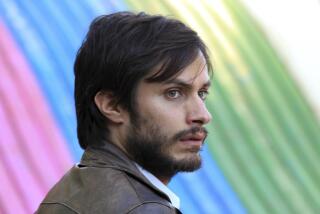A win-win combination
For more than half a century, choreographer Merce Cunningham has let chance determine the sequencing and collaborative relationships in his pieces -- a way, he has said, of discovering creative possibilities he might not have imagined.
What’s different about Cunningham’s “Split Sides” -- at the Ahmanson Theatre through Sunday -- is that he makes throwing the dice part of the show. Indeed, he now even enlists arts celebrities to do the throwing, including, on Thursday, Music Center dance honcho Renae Williams and performance artist Tim Miller.
Their actions determine which backdrop we see first (Robert Heishman’s or Catherine Yass’), the order of the music (Radiohead versus Sigur Ros), the initial choice of color or black-and-white costumes (both by James Hall), the specific lighting plot (by James F. Ingalls) and where exactly the various dance episodes fall in the 40-minute work.
But, dice or no dice, watching “Split Sides” isn’t any kind of gamble. After the celebs go away and the dancing begins, this 2-year-old ensemble piece delivers the usual Cunningham satisfactions: choreography and performances of extraordinary freshness and ingenuity.
At first, his technique may seem simplistic -- the taut, flat torsos with arms and legs rising stiffly like levers, the weightless, bounding jumps or runs that always seem to double back on themselves.
What’s more, it’s all so light and playful that you might not notice that Jonah Bokaer is doing jumps with no preparation -- as if suddenly yanked upward on some invisible string -- and can snap from a perfectly centered position to a dangerously cantilevered one with devastating exactitude.
In one duet, Holley Farmer maintains the serene balances of a prima ballerina while Daniel Squire supports her from the most warped and contorted positions imaginable: the extremes of classicism and modernism married with no sweat, no strain. “Split Sides” is all like this -- so easy, steady, uninsistent about its own brilliance.
Whatever the dice throwing might mandate on a particular night, the production components provide the dancing with radically contrasting environments: Heishman’s flurry of broken lines and pale tints versus Yass’ vertical emphasis and rich transparent colors.
Radiohead and Sigur Ros build their scores in layers -- the former incorporating bolder contrasts, the latter more evident structural gambits. Cunningham hadn’t worked with pop music before, and the innovation brings him not only a new audience but also new sound textures and energies that heat up the dance experience.
You might argue that the skittering lines decorating Hall’s costumes look better in black and white than when dipped in rose, gold and violet. But the result doesn’t prove nearly as problematic as the mottled blue, backless tops and gauzy skirts he designed for men and women in “Views on Stage,” the other half of the Thursday program.
Obviously it’s a surprise to find the Cunningham men in drag: This is not a choreographer who explores gender issues or camp titillation. More to the point, his movement looked much better on the men when they danced it in prismatic unitards for “Views on Camera,” a dance film that was the source for this 25-minute piece from 2004.
The film and its stage adaptation each use a score by Cunningham’s longtime partner, John Cage, that begins with spare piano punctuation and adds other instruments later on. Each also exploits contrasts between foreground and background action. But the film was shot in a bright dance studio, while Ernesto Neto has given the theater version a sense of mystery by designing an enormous torn canopy that seems to be melting or oozing into droplets above the heads of the dancers.
Squire begins the piece with a solo, and as it passes to Rashaun Mitchell and other male dancers, you see the vocabulary evolve and expand: quick upward stretches and jumps pulled emphatically downward by the force of gravity and held for a moment in its grip.
The solos become duets, and soon a women’s ensemble is exploring tiny pitter-pat footwork and balances on one leg. As the rest of this group continues in unison, Jennifer Goggans solos in front, her tilts and lunges looking like a virtuosic extension of the group patterning.
The piece accelerates, with lighting designer Josh Johnson recoloring the canopy, Cage introducing strings and percussion, and a series of overlapping, supremely inventive duets bringing the men and women together.
Typically for Cunningham, everything happens so fast, and there’s so much to see, that you have no time for analysis -- or even for cruising your favorite Cunningham hunk or honey -- before the lights fade on the last couple (Farmer and Squire) and come up on the curtain call.
Well, maybe along the way, you do manage to make one definitive observation about Merce Cunningham and his company: Sustained high achievement like this is never, ever a matter of chance.
*
Cunningham Dance Company
Where: Ahmanson Theatre, 135 N. Grand Ave., L.A.
When: 8 p.m. today, 2 p.m. Sunday
Price: $20 to $55
Contact: (213) 365-3500 or
(714) 740-7878
More to Read
The biggest entertainment stories
Get our big stories about Hollywood, film, television, music, arts, culture and more right in your inbox as soon as they publish.
You may occasionally receive promotional content from the Los Angeles Times.










